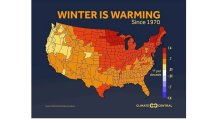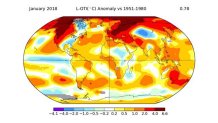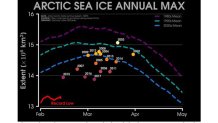No doubt about it: winters are getting warmer, and it’s not just in our area. Here’s the evidence from Climate Central.

The biggest warming is in the northern tier of states. In our area, we’re talking about nearly five decades. At .7 to 1.0 degrees per decade, that means about a FOUR degree rise in average winter temps. That means that EVERY day of winter averages FOUR degrees warmer than it did in 1970. If you say, "winters aren’t as severe as they were when I was young," you’re right!
Of course, the warming has covered more than just the U.S. The map below shows temperatures compared to “normal” in January. This one is in degrees Celsius, where 2 degrees C is close to 3 ½ degrees Fahrenheit. Those reddish areas show impressive warmth. That frigid blast we saw in early January looks pretty pitiful compared to the overall trend.

ARCTIC ICE: LOWER THAN THE LOWEST OF THE LOW
The story of arctic ice melt has not only continued, it’s getting worse. It’s not just a steady drop over the years. Individual weather patterns cause changes from year to year. So a rise in a year or two means nothing compared to the overall trend.
Here’s the trend of Arctic Ice Extent in January:

Here is another way of looking at Arctic Ice changes this century

Just like any weather trend, it doesn’t go up steadily every year. But the overall trend is clear. The above graph is based on a study that takes away the impacts of volcanoes (like Mt. Pinatubo in 1991) and years with strong El Nino and La Nina. The resulting green line is an even more clear-cut, steady rise. It even appears that rise has accelerated in recent years. Here’s the link to that study: Sea Level Rise Is Accelerating
ARCTIC ICE MELT & LINK TO WINTER COLD OUTBREAKS
Yes, it doesn’t seem to make sense. Warming of the earth leading to severe arctic outbreaks. That’s just one of the sometimes surprising impacts of the rapid melting of arctic ice. This is known as “Arctic Amplification.”
The link is related to the Polar Vortex, a common term among meteorologists but new for many other people. The stronger the Polar Vortex, the more likely Arctic air will stay in the Arctic. A weaker Polar Vortex allows “blocking patterns” to develop, leading to weather extremes. If you’re located in a certain part of the block, you’ll see an extended period of cold and/or snow. Stuck in another part of the block: an extended period of unseasonably mild weather.
The weak Polar Vortex/extreme weather connection got a lot of attention beginning more than 10 years ago when Professor Jennifer Francis of Rutgers University published articles on the subject. Here are links to some of her articles and interviews that are mostly non-technical.
Here are some links to other studies showing the connection.
This one gets pretty technical. You can just read the abstract.

